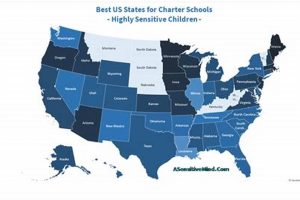Determining the highest-performing state education system is a complex question with no single, universally accepted answer. Various organizations and publications rank states based on different metrics, including standardized test scores, graduation rates, teacher qualifications, and per-pupil funding. For instance, one organization might emphasize academic outcomes, while another prioritizes equity and access. These varying methodologies often lead to different rankings, making it crucial to understand the criteria used in any given assessment.
A strong state education system is essential for individual and societal well-being. High-quality education correlates with increased earning potential, reduced poverty rates, and improved community health. Historically, state governments have played a pivotal role in shaping public education, and the pursuit of educational excellence continues to be a central focus of policy debates. Understanding how different states approach education can provide valuable insights into effective policies and best practices.
This article will explore the factors commonly used to evaluate state education systems, delve into the challenges of making direct comparisons, and examine various perspectives on what constitutes an effective and equitable learning environment. It will also highlight some leading states based on different ranking criteria and discuss future trends in education reform.
Tips for Evaluating State Education Systems
Assessing the quality of a state’s education system requires careful consideration of multiple factors. Relying solely on rankings can be misleading. A comprehensive analysis should incorporate both quantitative data and qualitative insights.
Tip 1: Examine Standardized Test Scores Cautiously: While standardized tests offer a snapshot of student performance, they do not capture the full picture of educational effectiveness. Consider factors like student demographics and test participation rates.
Tip 2: Investigate Graduation Rates and College Readiness: High school graduation rates and college enrollment figures can indicate a system’s ability to prepare students for future success. However, consider the rigor of coursework and the types of post-secondary institutions students attend.
Tip 3: Assess Teacher Quality and Professional Development: Teacher qualifications, experience, and ongoing professional development opportunities are crucial indicators of a state’s commitment to educational quality.
Tip 4: Analyze Per-Pupil Funding and Resource Allocation: Examine how states allocate resources to different schools and districts. Equity in funding can significantly impact educational outcomes.
Tip 5: Consider Early Childhood Education Programs: Access to high-quality early childhood education can have a lasting impact on student success throughout their academic journey. Investigate the availability and quality of pre-K programs.
Tip 6: Explore School Safety and Climate Data: A safe and supportive learning environment is essential for student well-being and academic achievement. Research school safety statistics and initiatives.
Tip 7: Review State Education Policies and Reforms: Understand the state’s educational priorities and initiatives. Look for evidence of innovation and continuous improvement efforts.
By considering these diverse aspects, a more nuanced and informative understanding of a state’s education system can be achieved. Focusing solely on single metrics risks overlooking crucial elements that contribute to student success.
This multi-faceted approach to evaluation offers a more complete understanding of the strengths and weaknesses of different state education systems, paving the way for informed discussions about improving educational opportunities for all students.
1. Student Performance
Student performance serves as a critical indicator in evaluating state education systems. While not the sole determinant, it offers valuable insights into the effectiveness of educational policies, resource allocation, and teaching methodologies. Examining student performance requires a multifaceted approach, considering standardized test scores alongside other metrics such as graduation rates, college enrollment, and post-secondary success. States with consistently high student performance across multiple measures often demonstrate a commitment to rigorous academic standards, effective teacher development programs, and equitable resource distribution. For example, states that invest heavily in early childhood education often see positive long-term impacts on student achievement. Conversely, states with significant achievement gaps between different student demographics may indicate systemic inequities requiring attention.
Analyzing student performance data also reveals the impact of specific educational reforms and interventions. States that implement data-driven instructional strategies and provide targeted support for struggling students often see improvements in overall academic outcomes. Furthermore, student performance data can inform policy decisions related to curriculum development, teacher training, and resource allocation. For instance, if data reveals weaknesses in a particular subject area, policymakers can adjust curriculum standards or provide additional professional development opportunities for teachers. The practical significance of understanding student performance lies in its ability to drive continuous improvement within state education systems. By identifying areas of strength and weakness, educators and policymakers can implement targeted strategies to enhance student learning and close achievement gaps.
In conclusion, while student performance is a complex and multifaceted issue, its analysis provides crucial insights for evaluating state education systems. By examining student performance data in conjunction with other relevant factors, stakeholders can gain a more comprehensive understanding of a state’s educational landscape and work towards creating more equitable and effective learning environments for all students. The challenge lies not just in measuring student performance, but in using that data effectively to inform policy and practice. Further research into the specific factors that contribute to high student performance can help states develop targeted interventions and improve educational outcomes for all students.
2. Funding and Resources
A strong correlation exists between funding and resources allocated to education and the overall quality of a state’s school system. Adequate funding provides the foundation for essential components of effective education, including qualified teachers, updated learning materials, appropriate class sizes, and access to technology and support services. States that invest significantly in education tend to demonstrate better student outcomes, higher graduation rates, and increased college readiness. Conversely, inadequate funding can lead to teacher shortages, outdated resources, and larger class sizes, potentially hindering student achievement and widening achievement gaps. For instance, states with higher per-pupil expenditures often exhibit stronger performance on standardized tests and higher graduation rates. Research consistently indicates that increased investment in education, particularly in low-income districts, yields substantial positive returns in terms of student achievement and long-term economic benefits.
The impact of funding extends beyond basic operational expenses. Resource allocation influences the availability of specialized programs, extracurricular activities, and support services for students with diverse learning needs. Well-funded schools can offer advanced placement courses, arts programs, and athletic opportunities that enrich the educational experience and contribute to well-rounded development. Moreover, adequate funding enables schools to provide essential support services such as counseling, special education programs, and English language learner programs, ensuring that all students have the resources they need to succeed. The availability of these resources can significantly impact student engagement, academic performance, and overall well-being. For example, schools with robust arts programs often see improved student creativity, critical thinking skills, and academic performance. Similarly, schools with comprehensive support services can better address the needs of students facing academic or emotional challenges, leading to improved outcomes.
Understanding the connection between funding and resources and the quality of a state’s education system is crucial for policymakers, educators, and communities. Advocating for increased and equitable funding for education can lead to improved student outcomes, reduced achievement gaps, and a stronger workforce. Strategic investment in education yields long-term benefits for individuals and society as a whole. The challenge lies in ensuring equitable distribution of resources to address disparities between districts and provide all students with access to a high-quality education, regardless of socioeconomic status or geographic location. Future research should focus on identifying the most effective resource allocation strategies to maximize student achievement and promote equitable educational opportunities.
3. Teacher Quality
Teacher quality stands as a cornerstone of effective education systems. A strong correlation exists between highly qualified teachers and improved student outcomes. States prioritizing teacher recruitment, training, and retention often exhibit higher student achievement, increased graduation rates, and a greater likelihood of college readiness. Examining teacher quality requires assessing various factors, including qualifications, experience, professional development opportunities, and teacher-student ratios. The following facets provide further insight into the connection between teacher quality and high-performing education systems.
- Teacher Qualifications and Certification
Rigorous qualification and certification standards ensure teachers possess the necessary knowledge, skills, and pedagogical expertise to effectively instruct students. States with high standards for teacher certification often attract and retain highly qualified educators. For example, states requiring advanced degrees in specific subject areas tend to have teachers with deeper content knowledge, which can translate to improved student learning. Conversely, lower certification standards can lead to a less qualified teacher workforce, potentially impacting student achievement negatively. Research consistently demonstrates a positive correlation between teacher qualifications and student outcomes, emphasizing the importance of robust certification processes in identifying and supporting effective educators.
- Professional Development and Ongoing Training
Continuous professional development opportunities are essential for teachers to stay abreast of current research, refine their instructional practices, and adapt to the evolving needs of students. States that invest in high-quality professional development programs empower teachers to enhance their skills, implement innovative teaching strategies, and improve student learning outcomes. Effective professional development programs often focus on data-driven instruction, differentiated learning techniques, and culturally responsive teaching practices. These opportunities allow teachers to personalize instruction, cater to diverse learning styles, and create more inclusive learning environments. By providing ongoing support and training, states can cultivate a highly skilled and adaptable teacher workforce capable of meeting the challenges of modern education.
- Teacher Experience and Retention
Teacher experience plays a significant role in shaping educational outcomes. Experienced teachers often possess deeper pedagogical knowledge, stronger classroom management skills, and a better understanding of student needs. High teacher turnover rates can disrupt student learning, create instability within schools, and negatively impact student achievement. States that prioritize teacher retention through competitive salaries, supportive working conditions, and opportunities for professional growth tend to have a more experienced and stable teacher workforce. This stability contributes to a positive school climate, fosters stronger teacher-student relationships, and ultimately leads to improved student outcomes. Investing in teacher retention strategies is a cost-effective way to improve the overall quality of a state’s education system.
- Class Size and Teacher-Student Ratio
Smaller class sizes and lower teacher-student ratios allow for more individualized attention, increased student engagement, and improved learning outcomes, particularly in younger grades. States with lower teacher-student ratios often demonstrate higher student achievement, especially in reading and mathematics. Smaller class sizes enable teachers to provide more personalized feedback, address individual student needs, and create a more supportive learning environment. This individualized attention can be especially beneficial for students who require additional support or those from disadvantaged backgrounds. While reducing class sizes can be costly, research suggests that the benefits in terms of improved student outcomes can outweigh the financial investment, particularly in high-need schools and districts.
These facets of teacher quality collectively contribute to a state’s overall educational effectiveness. Prioritizing teacher recruitment, training, professional development, and retention efforts creates a strong foundation for student success. States that invest in high-quality teachers are more likely to see improved student performance, increased graduation rates, and a more robust workforce. Further research examining the interplay of these factors can provide valuable insights for policymakers seeking to enhance the quality of their state’s education system. A comprehensive approach to improving teacher quality requires addressing all of these interconnected elements, creating a supportive and effective learning environment for both teachers and students.
4. Graduation Rates
Graduation rates serve as a critical indicator of a state’s educational effectiveness and contribute significantly to the ongoing discussion regarding the “best” school system. High graduation rates signify a system’s ability to support students through their academic journey, equipping them with the knowledge and skills necessary for future success. Conversely, low graduation rates can indicate underlying issues such as inadequate resources, ineffective teaching practices, or systemic inequities that hinder student progress. A comprehensive analysis of graduation rates, alongside other factors, provides valuable insights into a state’s educational landscape.
- On-Time Graduation Rates
On-time graduation rates reflect the percentage of students who complete their high school education within the standard four-year timeframe. This metric serves as a benchmark for measuring a state’s efficiency in supporting student progress and ensuring timely completion of academic requirements. High on-time graduation rates often correlate with effective instructional strategies, adequate resources, and supportive school environments. For instance, states with strong early intervention programs for struggling students tend to exhibit higher on-time graduation rates. Conversely, low on-time graduation rates may indicate the need for improved support systems, targeted interventions, or curriculum reforms to address student needs effectively.
- Extended Graduation Rates
Extended graduation rates encompass students who graduate within a timeframe exceeding the standard four years, often five or six years. This metric acknowledges that some students may require additional time and support to complete their high school education due to various circumstances, including learning differences, personal challenges, or transferring schools. Analyzing extended graduation rates alongside on-time rates provides a more nuanced understanding of a state’s ability to accommodate diverse student needs and provide flexible pathways to graduation. For example, states with robust support systems for students with disabilities or those facing economic hardship may exhibit higher extended graduation rates, reflecting their commitment to inclusive education.
- Graduation Rate Disparities
Examining graduation rate disparities across different student demographics, such as race, ethnicity, socioeconomic status, and disability status, reveals potential systemic inequities within a state’s education system. Significant gaps in graduation rates between different student groups may indicate unequal access to resources, discriminatory practices, or ineffective support systems for specific student populations. Addressing these disparities requires targeted interventions, culturally responsive teaching practices, and equitable resource allocation to ensure that all students have the opportunity to succeed. For instance, states that implement programs specifically designed to support students from low-income backgrounds or those with learning disabilities often see a reduction in graduation rate disparities, reflecting a more equitable education system.
- College and Career Readiness
Graduation rates, while important, should be considered alongside indicators of college and career readiness. A high school diploma should signify more than just completion of coursework; it should represent preparedness for post-secondary education, vocational training, or entry into the workforce. Examining metrics such as college enrollment rates, remediation rates in college, and employment outcomes provides a more comprehensive picture of a state’s ability to prepare students for future success. States with strong career and technical education programs, college counseling services, and partnerships with local businesses often see higher rates of college enrollment and successful transitions into the workforce, indicating a more effective preparation for post-secondary opportunities.
In conclusion, graduation rates offer a valuable lens through which to evaluate state education systems. Analyzing these rates in conjunction with other factors like student performance, teacher quality, and resource allocation contributes to a comprehensive understanding of a state’s educational landscape. High graduation rates coupled with strong indicators of college and career readiness suggest a system effectively equipping students for future success. However, addressing disparities and ensuring equitable access to resources and support services remains crucial for creating truly high-performing education systems that serve all students. Further research exploring the long-term impacts of graduation rates on individual and societal outcomes can provide valuable insights for policymakers seeking to improve educational opportunities and create a more equitable future.
5. Curriculum Standards
Curriculum standards play a pivotal role in shaping educational outcomes and contribute significantly to the ongoing debate surrounding the identification of high-performing state school systems. These standards define the knowledge and skills students are expected to acquire at each grade level, guiding instructional practices, assessment methods, and resource allocation. The rigor, coherence, and alignment of curriculum standards directly impact student achievement, college readiness, and workforce preparedness. States with clear, high-quality standards often exhibit stronger student performance and better prepare students for future success.
- Content Knowledge and Skills
Curriculum standards outline the specific content knowledge and skills students are expected to master in core subject areas such as mathematics, science, English language arts, and social studies. Well-defined standards ensure a consistent learning experience across schools and districts within a state, providing a framework for instructional planning and assessment. For example, states with rigorous mathematics standards that emphasize problem-solving and critical thinking skills tend to produce students with stronger analytical abilities. Conversely, vague or poorly defined standards can lead to inconsistencies in instruction and hinder student progress. The depth and breadth of content knowledge outlined in curriculum standards directly influence the academic rigor and overall quality of a state’s education system.
- Alignment and Coherence
Effective curriculum standards demonstrate vertical alignment and horizontal coherence. Vertical alignment ensures that learning builds progressively across grade levels, with each grade’s standards preparing students for the next. Horizontal coherence ensures that standards within a grade level connect meaningfully across different subject areas, fostering integrated learning and critical thinking. For instance, a well-aligned science curriculum might introduce basic scientific concepts in elementary school, build upon these concepts in middle school, and culminate in advanced scientific inquiry in high school. Similarly, horizontal coherence might involve connecting mathematical concepts to scientific applications or integrating historical context into literature studies. Strong alignment and coherence within curriculum standards promote a more cohesive and effective learning experience.
- Assessment and Accountability
Curriculum standards provide the foundation for assessment and accountability systems. Statewide assessments measure student progress against these standards, providing data that informs instructional practices, resource allocation, and policy decisions. Effective assessment systems align directly with the curriculum standards, ensuring that assessments accurately measure student mastery of the intended learning outcomes. Furthermore, accountability systems use assessment data to hold schools and districts accountable for student performance, incentivizing continuous improvement and promoting educational equity. Transparent and data-driven accountability systems can drive positive change within schools and improve educational outcomes for all students.
- Adaptability and Review
Curriculum standards should be adaptable and subject to regular review and revision to reflect advancements in knowledge, evolving societal needs, and emerging best practices in education. States that periodically review and update their standards ensure that students receive a relevant and up-to-date education that prepares them for the challenges of a rapidly changing world. For example, incorporating technological literacy standards into the curriculum reflects the increasing importance of technology in modern society. Similarly, revising science standards to reflect current scientific understanding ensures that students receive accurate and comprehensive scientific education. A dynamic approach to curriculum development ensures that standards remain relevant and responsive to the evolving needs of students and society.
In conclusion, curriculum standards serve as a critical component of effective education systems. Well-defined, rigorous, and coherent standards provide a framework for instruction, assessment, and accountability, directly impacting student achievement and future success. States that prioritize the development and implementation of high-quality curriculum standards create a strong foundation for educational excellence and contribute to the cultivation of a well-prepared workforce. The ongoing evaluation and refinement of curriculum standards, informed by research and best practices, ensure that education systems remain dynamic and responsive to the evolving needs of students and society. A focus on continuous improvement in curriculum development is essential for creating and maintaining a high-performing education system.
6. Equity and Access
Equity and access are integral components in evaluating state education systems and determining which offer the highest quality learning opportunities. A truly effective education system ensures that all students, regardless of background or circumstance, have access to the resources and support necessary to succeed. This encompasses equitable funding distribution, addressing disparities between districts, and providing specialized programs for students with diverse learning needs. For example, states demonstrating a commitment to equitable funding models, ensuring comparable resources for all schools regardless of socioeconomic demographics, tend to exhibit lower achievement gaps and higher overall student performance. Conversely, systems where funding disparities persist often perpetuate inequalities, hindering the academic progress of students in under-resourced schools. The presence of robust support systems for English language learners, students with disabilities, and those from low-income backgrounds indicates a commitment to equitable access and contributes significantly to a state’s overall educational quality.
The practical implications of prioritizing equity and access are far-reaching. States that invest in programs designed to address specific student needs, such as early intervention programs for struggling readers or specialized support for students with disabilities, often witness improved academic outcomes and reduced dropout rates among these targeted populations. Furthermore, equitable access to advanced coursework, extracurricular activities, and college counseling services can significantly impact students’ future opportunities. For instance, providing all students with access to challenging academic programs, regardless of their zip code, increases their likelihood of attending college and pursuing fulfilling careers. The long-term benefits of equitable education systems extend beyond individual student success, contributing to a more skilled workforce, stronger economic growth, and a more equitable society. The availability of resources, such as technology, qualified teachers, and updated learning materials, directly influences a student’s educational experience and potential for achievement. Ensuring equal access to these resources is a fundamental aspect of a high-quality education system.
In conclusion, equity and access are essential pillars of effective state education systems. States that prioritize equitable resource distribution, address achievement gaps, and provide tailored support for diverse learners create a foundation for student success and contribute to a more just and prosperous society. Evaluating state education systems requires a comprehensive analysis that considers not only overall student performance but also the equitable distribution of resources and opportunities. Addressing systemic inequities and ensuring that all students have access to a high-quality education, regardless of background, is crucial for fostering a truly high-performing and equitable education system. Future policy decisions should prioritize funding models that promote equity, support programs that address specific student needs, and ensure that all students have the opportunity to reach their full potential. The challenge lies in implementing policies and practices that translate this understanding into tangible improvements in educational outcomes for all students.
Frequently Asked Questions about State Education Systems
This section addresses common inquiries regarding the complexities of evaluating and comparing state education systems.
Question 1: Is there a single, definitive ranking of state education systems?
No single ranking definitively identifies the “best” state education system. Various organizations employ different methodologies and prioritize different metrics, resulting in varied rankings. It’s crucial to understand the specific criteria used in any given ranking to interpret the results accurately.
Question 2: Why do different rankings produce different results?
Variations in ranking methodologies account for differing results. Some rankings emphasize standardized test scores, while others prioritize graduation rates, funding levels, or equity measures. The chosen metrics significantly influence the final rankings.
Question 3: How can one effectively compare state education systems?
Effective comparison requires considering multiple factors beyond rankings. Analyzing student performance, teacher quality, resource allocation, and educational policies provides a more comprehensive understanding of a state’s educational landscape.
Question 4: What role does funding play in the quality of a state’s education system?
Funding plays a crucial role. Adequate funding enables states to attract and retain qualified teachers, provide essential resources, implement effective programs, and reduce class sizes, all of which contribute to improved student outcomes.
Question 5: How do state demographics influence educational outcomes?
State demographics, such as poverty rates and language diversity, can influence educational outcomes. States with higher proportions of students from disadvantaged backgrounds may face greater challenges in achieving high levels of student performance. However, effective programs and equitable resource allocation can mitigate these challenges.
Question 6: What are some key indicators of an effective state education system?
Key indicators include strong student performance, high graduation rates, low dropout rates, equitable resource distribution, highly qualified teachers, and a commitment to continuous improvement.
Understanding these factors enables a more nuanced evaluation of state education systems beyond simple rankings. Further research and analysis contribute to informed decision-making and ongoing efforts to improve educational opportunities for all students.
This FAQ section provides a starting point for further exploration of state education systems. Consulting individual state education department websites and reputable research organizations offers additional valuable insights.
Which State Has the Best School System
Determining the state with the “best” school system requires a nuanced approach, moving beyond simplistic rankings to consider a multitude of factors. This exploration has highlighted the complexities of comparing diverse state education systems, emphasizing the importance of examining not just standardized test scores, but also graduation rates, teacher quality, resource allocation, curriculum standards, and equity of access. Each state possesses unique strengths and weaknesses, making direct comparisons challenging and often misleading. The focus should shift from seeking a single “best” system to identifying best practices and effective policies that can inform improvements across all states.
The pursuit of educational excellence requires ongoing evaluation, innovation, and a commitment to equitable opportunities for all students. Further research and analysis are crucial for understanding the multifaceted factors that contribute to student success and for developing effective strategies to address persistent challenges. The future of education relies on continuous improvement, informed decision-making, and a collective dedication to providing every student with the tools they need to thrive. Ultimately, the question is not simply which state currently boasts the “best” system, but how each state can strive towards continuous improvement and equitable access to high-quality education for all learners.







